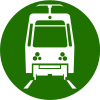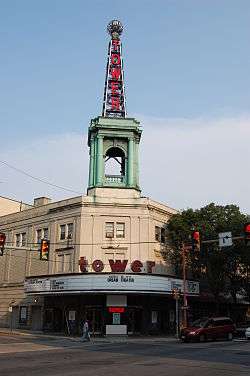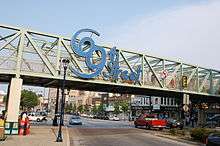SEPTA Routes 101 and 102
SEPTA Routes 101 and 102,[5] also known as the Media–Sharon Hill Line,[6] are light rail lines operated by the Suburban Transit Division of the Southeastern Pennsylvania Transportation Authority, serving portions of Delaware County. The routes' eastern terminus is 69th Street Transportation Center in Upper Darby, Pennsylvania. Route 101 runs to Media, while Route 102 goes to Sharon Hill. Altogether, the two lines operate on approximately 11.9 miles (19.2 km) of route.[2] The lines were formerly interurbans.
| Routes 101 and 102 Media–Sharon Hill Line | |||||||||||||||||||||||||||||||||||||||||||||||||||||||||||||||||||||||||||||||||||||||||||||||||||||||||||||||||||||||||||||||||||||||||||||||||||||||||||||||||||||||||||||||||||||||||||||||||||||||||||||||||||||||||||||||||||||||||||||||||||||||||||||||||||||||||||||||||||||||||||||||||||||||||||||||||||||
|---|---|---|---|---|---|---|---|---|---|---|---|---|---|---|---|---|---|---|---|---|---|---|---|---|---|---|---|---|---|---|---|---|---|---|---|---|---|---|---|---|---|---|---|---|---|---|---|---|---|---|---|---|---|---|---|---|---|---|---|---|---|---|---|---|---|---|---|---|---|---|---|---|---|---|---|---|---|---|---|---|---|---|---|---|---|---|---|---|---|---|---|---|---|---|---|---|---|---|---|---|---|---|---|---|---|---|---|---|---|---|---|---|---|---|---|---|---|---|---|---|---|---|---|---|---|---|---|---|---|---|---|---|---|---|---|---|---|---|---|---|---|---|---|---|---|---|---|---|---|---|---|---|---|---|---|---|---|---|---|---|---|---|---|---|---|---|---|---|---|---|---|---|---|---|---|---|---|---|---|---|---|---|---|---|---|---|---|---|---|---|---|---|---|---|---|---|---|---|---|---|---|---|---|---|---|---|---|---|---|---|---|---|---|---|---|---|---|---|---|---|---|---|---|---|---|---|---|---|---|---|---|---|---|---|---|---|---|---|---|---|---|---|---|---|---|---|---|---|---|---|---|---|---|---|---|---|---|---|---|---|---|---|---|---|---|---|---|---|---|---|---|---|---|---|---|---|---|---|---|---|---|---|---|---|---|---|---|---|---|---|---|---|---|---|---|---|---|---|---|---|---|---|---|---|---|---|---|---|---|
 | |||||||||||||||||||||||||||||||||||||||||||||||||||||||||||||||||||||||||||||||||||||||||||||||||||||||||||||||||||||||||||||||||||||||||||||||||||||||||||||||||||||||||||||||||||||||||||||||||||||||||||||||||||||||||||||||||||||||||||||||||||||||||||||||||||||||||||||||||||||||||||||||||||||||||||||||||||||
Route 102 at Sharon Hill station | |||||||||||||||||||||||||||||||||||||||||||||||||||||||||||||||||||||||||||||||||||||||||||||||||||||||||||||||||||||||||||||||||||||||||||||||||||||||||||||||||||||||||||||||||||||||||||||||||||||||||||||||||||||||||||||||||||||||||||||||||||||||||||||||||||||||||||||||||||||||||||||||||||||||||||||||||||||
| Overview | |||||||||||||||||||||||||||||||||||||||||||||||||||||||||||||||||||||||||||||||||||||||||||||||||||||||||||||||||||||||||||||||||||||||||||||||||||||||||||||||||||||||||||||||||||||||||||||||||||||||||||||||||||||||||||||||||||||||||||||||||||||||||||||||||||||||||||||||||||||||||||||||||||||||||||||||||||||
| Type | Light rail | ||||||||||||||||||||||||||||||||||||||||||||||||||||||||||||||||||||||||||||||||||||||||||||||||||||||||||||||||||||||||||||||||||||||||||||||||||||||||||||||||||||||||||||||||||||||||||||||||||||||||||||||||||||||||||||||||||||||||||||||||||||||||||||||||||||||||||||||||||||||||||||||||||||||||||||||||||||
| Locale | Delaware County, Pennsylvania | ||||||||||||||||||||||||||||||||||||||||||||||||||||||||||||||||||||||||||||||||||||||||||||||||||||||||||||||||||||||||||||||||||||||||||||||||||||||||||||||||||||||||||||||||||||||||||||||||||||||||||||||||||||||||||||||||||||||||||||||||||||||||||||||||||||||||||||||||||||||||||||||||||||||||||||||||||||
| Termini | Media-Orange Street (Route 101) Sharon Hill (Route 102) 69th Street Transportation Center | ||||||||||||||||||||||||||||||||||||||||||||||||||||||||||||||||||||||||||||||||||||||||||||||||||||||||||||||||||||||||||||||||||||||||||||||||||||||||||||||||||||||||||||||||||||||||||||||||||||||||||||||||||||||||||||||||||||||||||||||||||||||||||||||||||||||||||||||||||||||||||||||||||||||||||||||||||||
| Stations | 52 | ||||||||||||||||||||||||||||||||||||||||||||||||||||||||||||||||||||||||||||||||||||||||||||||||||||||||||||||||||||||||||||||||||||||||||||||||||||||||||||||||||||||||||||||||||||||||||||||||||||||||||||||||||||||||||||||||||||||||||||||||||||||||||||||||||||||||||||||||||||||||||||||||||||||||||||||||||||
| Services | 2
| ||||||||||||||||||||||||||||||||||||||||||||||||||||||||||||||||||||||||||||||||||||||||||||||||||||||||||||||||||||||||||||||||||||||||||||||||||||||||||||||||||||||||||||||||||||||||||||||||||||||||||||||||||||||||||||||||||||||||||||||||||||||||||||||||||||||||||||||||||||||||||||||||||||||||||||||||||||
| Daily ridership | Route 101: 4,400 Route 102: 3,576 (average weekday, FY 2014)[1] | ||||||||||||||||||||||||||||||||||||||||||||||||||||||||||||||||||||||||||||||||||||||||||||||||||||||||||||||||||||||||||||||||||||||||||||||||||||||||||||||||||||||||||||||||||||||||||||||||||||||||||||||||||||||||||||||||||||||||||||||||||||||||||||||||||||||||||||||||||||||||||||||||||||||||||||||||||||
| Operation | |||||||||||||||||||||||||||||||||||||||||||||||||||||||||||||||||||||||||||||||||||||||||||||||||||||||||||||||||||||||||||||||||||||||||||||||||||||||||||||||||||||||||||||||||||||||||||||||||||||||||||||||||||||||||||||||||||||||||||||||||||||||||||||||||||||||||||||||||||||||||||||||||||||||||||||||||||||
| Opened | 1906 | ||||||||||||||||||||||||||||||||||||||||||||||||||||||||||||||||||||||||||||||||||||||||||||||||||||||||||||||||||||||||||||||||||||||||||||||||||||||||||||||||||||||||||||||||||||||||||||||||||||||||||||||||||||||||||||||||||||||||||||||||||||||||||||||||||||||||||||||||||||||||||||||||||||||||||||||||||||
| Operator(s) | SEPTA | ||||||||||||||||||||||||||||||||||||||||||||||||||||||||||||||||||||||||||||||||||||||||||||||||||||||||||||||||||||||||||||||||||||||||||||||||||||||||||||||||||||||||||||||||||||||||||||||||||||||||||||||||||||||||||||||||||||||||||||||||||||||||||||||||||||||||||||||||||||||||||||||||||||||||||||||||||||
| Character | Surface (at-grade) | ||||||||||||||||||||||||||||||||||||||||||||||||||||||||||||||||||||||||||||||||||||||||||||||||||||||||||||||||||||||||||||||||||||||||||||||||||||||||||||||||||||||||||||||||||||||||||||||||||||||||||||||||||||||||||||||||||||||||||||||||||||||||||||||||||||||||||||||||||||||||||||||||||||||||||||||||||||
| Technical | |||||||||||||||||||||||||||||||||||||||||||||||||||||||||||||||||||||||||||||||||||||||||||||||||||||||||||||||||||||||||||||||||||||||||||||||||||||||||||||||||||||||||||||||||||||||||||||||||||||||||||||||||||||||||||||||||||||||||||||||||||||||||||||||||||||||||||||||||||||||||||||||||||||||||||||||||||||
| Line length | 11.9 mi (19.2 km)[2] | ||||||||||||||||||||||||||||||||||||||||||||||||||||||||||||||||||||||||||||||||||||||||||||||||||||||||||||||||||||||||||||||||||||||||||||||||||||||||||||||||||||||||||||||||||||||||||||||||||||||||||||||||||||||||||||||||||||||||||||||||||||||||||||||||||||||||||||||||||||||||||||||||||||||||||||||||||||
| Track gauge | PA gauge 5 ft 2 1⁄4 in (1,581 mm)[3][4] | ||||||||||||||||||||||||||||||||||||||||||||||||||||||||||||||||||||||||||||||||||||||||||||||||||||||||||||||||||||||||||||||||||||||||||||||||||||||||||||||||||||||||||||||||||||||||||||||||||||||||||||||||||||||||||||||||||||||||||||||||||||||||||||||||||||||||||||||||||||||||||||||||||||||||||||||||||||
| Electrification | Overhead lines | ||||||||||||||||||||||||||||||||||||||||||||||||||||||||||||||||||||||||||||||||||||||||||||||||||||||||||||||||||||||||||||||||||||||||||||||||||||||||||||||||||||||||||||||||||||||||||||||||||||||||||||||||||||||||||||||||||||||||||||||||||||||||||||||||||||||||||||||||||||||||||||||||||||||||||||||||||||
| |||||||||||||||||||||||||||||||||||||||||||||||||||||||||||||||||||||||||||||||||||||||||||||||||||||||||||||||||||||||||||||||||||||||||||||||||||||||||||||||||||||||||||||||||||||||||||||||||||||||||||||||||||||||||||||||||||||||||||||||||||||||||||||||||||||||||||||||||||||||||||||||||||||||||||||||||||||
Along with the Norristown High Speed Line, formerly the Philadelphia and Western Railroad, the routes are the remaining lines of the Red Arrow Trolley System once operated by the Philadelphia Suburban Transportation Company (successor to the Philadelphia and West Chester Traction Company); some local residents still call them "Red Arrow".
This route uses 29 Kawasaki Heavy Industries Rolling Stock Company Series 100 LRV cars similar to those used on the SEPTA Subway–Surface Trolley Lines. However, unlike the city cars, the Series 100 cars on Routes 101 and 102 are double-ended and use pantograph collection instead of trolley poles.
Current system
| Route | Length[7] | South terminal | North terminal |
|---|---|---|---|
| 101 | 8.6 miles (13.8 km) | Media Orange Street at State Street |
Upper Darby 69th Street Transportation Center |
| 102 | 5.3 miles (8.5 km) | Sharon Hill Sharon Hill | |
The 101 and 102 run together on their exclusive right-of-way from Upper Darby to Drexel Hill Junction for approximately 2 miles (3.2 km), at which point they diverge.

Route 101 continues on its own right-of-way traveling west and southwest through Drexel Hill and Springfield with an important stop at the Springfield Mall before entering the street in Media. The 101 has double tracks to Woodland Avenue, then a single track to just before Pine Ridge, then enters the street at Providence Road in Media and runs on a single track the rest of the way. Cars in the street must yield to the trolley. The line terminates in the middle of the street just west of the Delaware County Courthouse.
Route 102 runs southeast from Drexel Hill Junction through Drexel Hill and Clifton Heights and then goes into the street in Aldan. After Aldan, it returns to its own right-of-way, then passes through Collingdale before terminating at Chester Pike in Sharon Hill. The 102 has double tracks until up to North Street in Collingdale, where the 102 returns to its own right-of-way, and after North Street, there is a single track until the end of the line.
Springfield Road contains two stops along both lines. Route 101 stops at Springfield Road in Springfield. Route 102 stops at Springfield Road in Clifton Heights, then joins this street until it moves onto Woodlawn Avenue through Aldan.
History

The Sharon Hill Line (Route 102) was originally built by the Philadelphia and West Chester Traction Company, and opened on March 15, 1906, and the Media Line (Route 101) was originally built by the same company, opening on April 1, 1913.[8] The lines were later bought by the Philadelphia Suburban Transit Company in 1954.
Besides Routes 101 and 102, there were also two other, now defunct, Red Arrow trolley lines. The direct ancestor of the SEPTA Route 104 bus line went to West Chester, splitting off from the rest of the system right after 69th Street Transportation Center onto West Chester Pike. The tracks continued all the way up West Chester Pike. West Chester trolleys were replaced by buses in 1954 due to widening of West Chester Pike; rush-hour trips to Westgate Hills lasted until 1958. Tracks remained in use for access to the Red Arrow's carbarn in Llanerch until SEPTA closed the barn in 1971; all tracks were soon removed except for a portion near 69th Street that SEPTA occasionally uses to store out-of service trolleys. The other now-defunct Red Arrow trolley line went to Ardmore until December 1966. It split from the West Chester line at Llanerch and continued on its own exclusive right-of-way. Much of the right-of-way still remains between Schauffele Plaza in Ardmore (the former terminus of the line) and Eagle Road in Havertown, although the tracks were removed and the right-of-way paved for dedicated use by the replacement bus line, now SEPTA Route 103. The 103 still uses this private right-of-way, although much of its other street routing has changed.
On April 1, 2020, service on Route 102 was suspended while Route 101 was substituted with buses due to the COVID-19 pandemic. Trolley service on both routes resumed June 1, 2020.[9][10][11]
Media stops
Route 101 trolley at the end of the line | |||||||||||
| Line(s) | |||||||||||
| Platforms | Sidewalks | ||||||||||
| Tracks | 1 | ||||||||||
| Construction | |||||||||||
| Platform levels | Street | ||||||||||
| Parking | No | ||||||||||
| Electrified | Overhead lines | ||||||||||
| Services | |||||||||||
| |||||||||||
Media is the western terminus of the Route 101 trolley line. Despite being located in the town, there is no direct connection to the Media station of the Media/Elwyn Line.
| Location | Station/stop | Connections | Notes | |
|---|---|---|---|---|
| Route 101 (Media branch) | ||||
| Media | Orange Street – State Street | Route 101 western terminus | ||
| Veterans Square – State Street | ||||
| Olive Street – State Street | ||||
| Jackson Street – State Street | ||||
| Monroe Street – State Street | ||||
| Edgemont Street – State Street | ||||
| Manchester Avenue – State Street | ||||
Stations and stops
| Location | Station/stop | Connections | Notes | |
|---|---|---|---|---|
| Media | Begin right-of-way and two-track operation Formerly known as Bowling Green | |||
| Beatty Road | ||||
| Springfield | Tracks converge east of here | |||
| Paper Mill Road | Serves Smedley Park | |||
| Formerly known as Sproul Road | ||||
| Thomson Avenue | ||||
| Woodland Avenue | Resume two-track operation east of here | |||
| Leamy Avenue | ||||
| Saxer Avenue | ||||
| Drexel Hill | ||||
| Drexelbrook | ||||
| Anderson Avenue | ||||
| Aronimink | ||||
| School Lane | ||||
| Huey Avenue | ||||
| Route 102 (Sharon Hill branch) | ||||
| Sharon Hill | Sharon Hill – Chester Pike | Route 102 western terminus | ||
| Collingdale | MacDade Boulevard – Woodlawn Avenue | Formerly known as Collingdale | ||
| Andrews Avenue – Woodlawn Avenue | ||||
| Bartram Avenue – Woodlawn Avenue | ||||
| North Street – Woodlawn Avenue | Tracks leave right-of-way and merge with Woodlawn Avenue north of here | |||
| Aldan | Magnolia Avenue – Woodlawn Avenue | |||
| Providence Road – Woodlawn Avenue | ||||
| Shisler Avenue – Woodlawn Avenue | Station closed on March 15, 2010 | |||
| Clifton Heights | Clifton-Aldan – Woodlawn Avenue | Tracks transition onto Springfield Road | ||
| Springfield Road | Tracks leave Springfield Road for right-of-way south of here | |||
| Penn Street | ||||
| Baltimore Pike | ||||
| Drexel Hill | Creek Road | Located in Indian Rock Park Formerly known as Oakdale | ||
| Marshall Road | ||||
| Drexel Manor | ||||
| Garrettford | ||||
| Routes 101 & 102 (Common section) | ||||
| Drexel Hill | Drexel Hill Junction | Also known as Shadeland Avenue Routes 101 and 102 diverge west of here | ||
| Irvington Road | Bypassed by Route 101 rush hour express service | |||
| Drexel Park | Bypassed by Route 101 rush hour express service Also called Fairfax Road | |||
| Upper Darby | Lansdowne Avenue – Garrett Road | |||
| Congress Avenue – Garrett Road | Bypassed by Route 101 rush hour express service | |||
| Beverly Boulevard – Garrett Road & Bywood Avenue | Bypassed by Route 101 rush hour express service Formerly known as Beverly Hills | |||
| Hilltop Road – Garrett Road & Bywood Avenue | Bypassed by Route 101 rush hour express service | |||
| Avon Road – Garrett Road & Bywood Avenue | Bypassed by Route 101 rush hour express service Formerly known as Bywood | |||
| Walnut Street – Garrett Road & Bywood Avenue | Bypassed by Route 101 rush hour express service | |||
| Fairfield Avenue – Bywood Avenue | Bypassed by Route 101 rush hour express service Tracks merge with street east of here | |||
| 69th Street Transportation Center – Market Street | ||||
.jpg) Route 101 LRV in Media
Route 101 LRV in Media.jpg) Private right-of-way outside Media
Private right-of-way outside Media.jpg) Front of Route 101 LRV in Media with the sign set for its next outbound trip to Sharon Hill on Route 102.
Front of Route 101 LRV in Media with the sign set for its next outbound trip to Sharon Hill on Route 102.
References
- "Fiscal Year 2014 Annual Service Plan" (PDF). SEPTA. May 2013. p. 42. Archived from the original (pdf) on September 22, 2013. Retrieved June 19, 2014.
- Demery, Leroy W. Jr. (November 2011). "U.S. Urban Rail Transit Lines Opened From 1980" (PDF). publictransit.us. pp. 37–40. Archived from the original (pdf) on November 4, 2013. Retrieved November 2, 2013.
- "The history of trolley cars and routes in Philadelphia". SEPTA. June 1, 1974. p. 2. Retrieved June 11, 2014.
An early city ordinance prescribed that all tracks were to have a gauge of 5' 2 1⁄4.
- Hilton, George W.; Due, John Fitzgerald (January 1, 2000). The Electric Interurban Railways in America. Stanford University Press. Retrieved June 10, 2014.
- "101 and 102 Official map". Retrieved July 22, 2018.
- "SEPTA Capital Improvements in Delaware County" (PDF). SEPTA. December 2007. p. 4. Retrieved January 4, 2008.
- "SEPTA – Spring 2012 Route Statistics" (PDF). Southeastern Pennsylvania Transportation Authority. 2012. Retrieved 2013-06-28.
- "Philadelphia Suburban Transit Routes". ChicagoRailFan.net.
- "Service Information". SEPTA. Retrieved April 14, 2020.
- "SEPTA Transit Network Lifeline Service Schedule" (PDF). SEPTA. April 2020. Retrieved April 14, 2020.
- "Service Temporarily Suspended" (PDF). SEPTA. Retrieved April 14, 2020.
External links
| Wikimedia Commons has media related to SEPTA Routes 101 and 102. |

